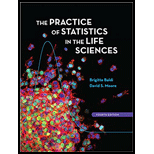
(a)
To find out how many observations per group does your analysis use.
(a)
Answer to Problem 26.39E
The number of observations per group is
Explanation of Solution
In the question, it is given that for the table
| Nitrogen 0 | Nitrogen 28 | Nitrogen 160 | |
| Phosphorus | 0.29 | 0.21 | 0.18 |
| 0.25 | 0.24 | 0.2 | |
| 0.27 | 0.21 | 0.19 | |
| 0.24 | 0.22 | 0.19 | |
| 0.24 | 0.19 | 0.16 | |
| 0.2 | 0.17 | 0.34 | |
| 0.64 | 0.41 | 0.31 | |
| 0.54 | 0.37 | 0.36 | |
| 0.53 | 0.5 | 0.37 | |
| 0.52 | 0.43 | 0.26 | |
| 0.41 | 0.39 | 0.17 | |
| 0.43 | 0.44 | 0.27 |
Thus, as we can see that there are three groups namely nitrogen
(b)
To explain what do you conclude from the F statistic and P-value.
(b)
Answer to Problem 26.39E
We have sufficient evidence to conclude that at least one mean is different from the other mean.
Explanation of Solution
In the question, it is given that for the table
| Nitrogen 0 | Nitrogen 28 | Nitrogen 160 | |
| Phosphorus | 0.29 | 0.21 | 0.18 |
| 0.25 | 0.24 | 0.2 | |
| 0.27 | 0.21 | 0.19 | |
| 0.24 | 0.22 | 0.19 | |
| 0.24 | 0.19 | 0.16 | |
| 0.2 | 0.17 | 0.34 | |
| 0.64 | 0.41 | 0.31 | |
| 0.54 | 0.37 | 0.36 | |
| 0.53 | 0.5 | 0.37 | |
| 0.52 | 0.43 | 0.26 | |
| 0.41 | 0.39 | 0.17 | |
| 0.43 | 0.44 | 0.27 |
Now, let us do the one-way analysis for this data by Excel. In Excel go to the data tab and then click on the data analysis option. Then the dialogue box will appear from which select the ANOVA one factor and then another dialogue box will appear and in that select the data and fill the entries and then click ok. Then the result will be as:
| ANOVA | ||||||
| Source of Variation | SS | df | MS | F | P-value | F crit |
| Between Groups | 0.1014 | 2 | 0.0507 | 3.565097 | 0.039646 | 3.284918 |
| Within Groups | 0.4693 | 33 | 0.01422121 | |||
| Total | 0.5707 | 35 |
As we know that if the P-value is less than or equal to the significance level then the null hypothesis is rejected and also we can see from the result that the F statistics value is greater thenF critical value, so we have,
Thus, we have sufficient evidence to conclude that at least one mean is different from the other mean.
(c)
To find out which pairwise differences of means for the three nitrogen levels are significant at the overall
(c)
Answer to Problem 26.39E
Explanation of Solution
In the question, it is given that for the table
| Nitrogen 0 | Nitrogen 28 | Nitrogen 160 | |
| Phosphorus | 0.29 | 0.21 | 0.18 |
| 0.25 | 0.24 | 0.2 | |
| 0.27 | 0.21 | 0.19 | |
| 0.24 | 0.22 | 0.19 | |
| 0.24 | 0.19 | 0.16 | |
| 0.2 | 0.17 | 0.34 | |
| 0.64 | 0.41 | 0.31 | |
| 0.54 | 0.37 | 0.36 | |
| 0.53 | 0.5 | 0.37 | |
| 0.52 | 0.43 | 0.26 | |
| 0.41 | 0.39 | 0.17 | |
| 0.43 | 0.44 | 0.27 |
Thus, to find the confidence interval for mean we will use the calculator
Thus, as we can see that in the group
(d)
To explain do you think these pairwise comparisons are useful for these data.
(d)
Explanation of Solution
In the question, it is given that for the table
As we can see that these pairwise comparisons are useful for these data because they can independently represent the data for the study and we can specify that which means for the groups are significant and which are not significant to each other.
Want to see more full solutions like this?
Chapter 26 Solutions
Practice of Statistics in the Life Sciences
 MATLAB: An Introduction with ApplicationsStatisticsISBN:9781119256830Author:Amos GilatPublisher:John Wiley & Sons Inc
MATLAB: An Introduction with ApplicationsStatisticsISBN:9781119256830Author:Amos GilatPublisher:John Wiley & Sons Inc Probability and Statistics for Engineering and th...StatisticsISBN:9781305251809Author:Jay L. DevorePublisher:Cengage Learning
Probability and Statistics for Engineering and th...StatisticsISBN:9781305251809Author:Jay L. DevorePublisher:Cengage Learning Statistics for The Behavioral Sciences (MindTap C...StatisticsISBN:9781305504912Author:Frederick J Gravetter, Larry B. WallnauPublisher:Cengage Learning
Statistics for The Behavioral Sciences (MindTap C...StatisticsISBN:9781305504912Author:Frederick J Gravetter, Larry B. WallnauPublisher:Cengage Learning Elementary Statistics: Picturing the World (7th E...StatisticsISBN:9780134683416Author:Ron Larson, Betsy FarberPublisher:PEARSON
Elementary Statistics: Picturing the World (7th E...StatisticsISBN:9780134683416Author:Ron Larson, Betsy FarberPublisher:PEARSON The Basic Practice of StatisticsStatisticsISBN:9781319042578Author:David S. Moore, William I. Notz, Michael A. FlignerPublisher:W. H. Freeman
The Basic Practice of StatisticsStatisticsISBN:9781319042578Author:David S. Moore, William I. Notz, Michael A. FlignerPublisher:W. H. Freeman Introduction to the Practice of StatisticsStatisticsISBN:9781319013387Author:David S. Moore, George P. McCabe, Bruce A. CraigPublisher:W. H. Freeman
Introduction to the Practice of StatisticsStatisticsISBN:9781319013387Author:David S. Moore, George P. McCabe, Bruce A. CraigPublisher:W. H. Freeman





